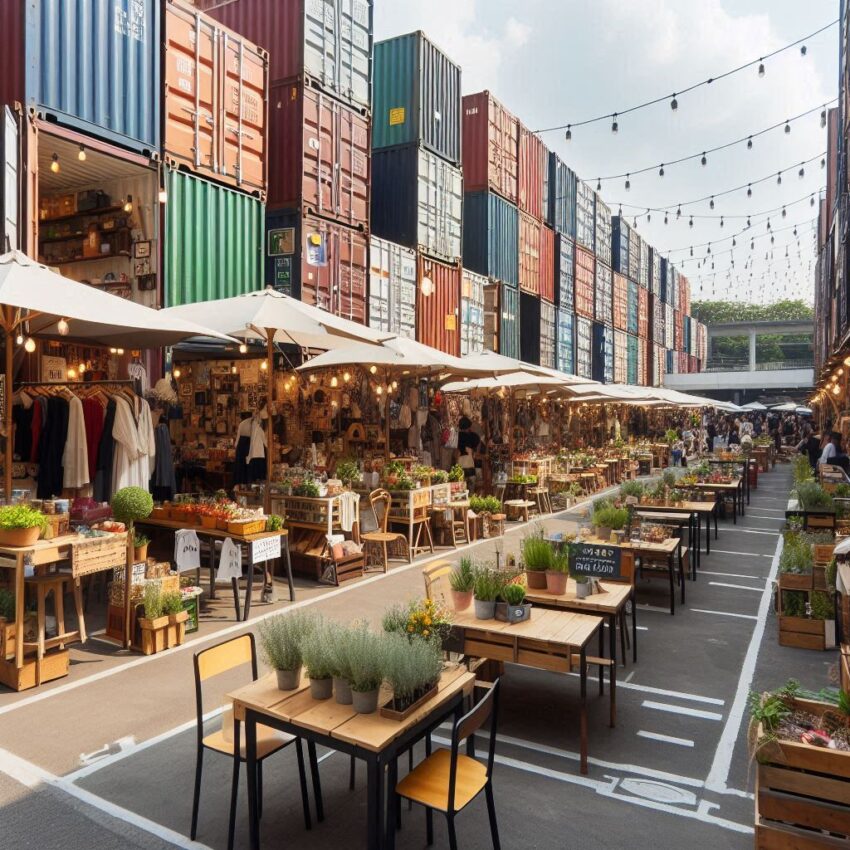 Shipping containers are known for durability and strength, possessing the unique benefit of modularity. These qualities make them incredibly versatile. While traditionally used for transporting goods, shipping containers are finding new life through creative, practical applications. From container homes to pop-up shops and emergency shelters, repurposed shipping containers are shaping modern architecture and design. This article delves into various novel and functional ways shipping containers are being utilized.
Shipping containers are known for durability and strength, possessing the unique benefit of modularity. These qualities make them incredibly versatile. While traditionally used for transporting goods, shipping containers are finding new life through creative, practical applications. From container homes to pop-up shops and emergency shelters, repurposed shipping containers are shaping modern architecture and design. This article delves into various novel and functional ways shipping containers are being utilized.
Container Homes
Container homes are at the forefront of the repurposed shipping container movement. These structures offer an eco-friendly and cost-effective alternative to traditional housing.
One key advantage is their ability for customization. Architects can combine and arrange containers to create unique layouts, allowing for personalized and flexible floor plans. This feature makes container homes appealing for those who prefer unique, tailored living spaces.
Another benefit is the potential for off-grid living. Container homes often incorporate solar panels, rainwater harvesting systems, and green roofs, which minimize environmental impact. These features make container homes a sustainable option for eco-conscious individuals.
The affordability factor cannot be overlooked. Constructing a container home generally costs less than building a conventional house. This cost-effectiveness opens the door to homeownership for many who might otherwise be priced out of the market.
Pop-Up Shops
Pop-up shops demonstrate how repurposed shipping containers can revolutionize retail. These temporary stores provide a flexible, agile retail solution, perfect for businesses wishing to test new markets or promote products.
The mobility of container shops is a standout feature. Unlike permanent retail spaces, these structures can be easily transported to different locations. This characteristic is advantageous for reaching a broader audience without committing to a long-term lease in a single area.
Durability is another important aspect. Shipping containers are built to withstand harsh conditions at sea, lending them robustness that prolongs their lifespan in retail settings. This durability ensures the protection of merchandise and the longevity of the shop structure itself.
The aesthetic appeal of container pop-up shops cannot be ignored. Their industrial look can attract curious customers, making them ideal for trendy brands aiming to create a buzz. With some creativity, these shops can be transformed into visually stunning retail destinations.
Emergency Shelters
Repurposed shipping containers are also being utilized to address urgent housing needs. In disaster scenarios, creating quick and reliable shelter solutions is paramount. Shipping containers offer a solution that is rapid and robust.
Their stackable nature allows for efficient use of space, crucial in areas where land availability may be limited. Multiple units can be easily transported and assembled in short periods, expediting the process of establishing a functional shelter village.
Shipping containers provide a weather-resistant and secure solution, protecting occupants from harsh conditions. They can also be retrofitted with additional insulation, heating, and cooling systems to enhance livability.
The cost-effectiveness of container shelters is another significant factor. Compared to constructing traditional buildings, repurposed shipping containers offer a budget-friendly alternative that doesn’t sacrifice durability or safety.
Offices and Studios
Containers are being repurposed as offices and studios, appealing to businesses and creatives who need adaptable and efficient workspaces. These structures can be customized to fit the specific needs of various enterprises, providing an innovative and practical workspace solution.
One of the primary attractions is the customizable nature of container offices. Walls can be modified, added, or removed to create an optimal layout for specific tasks. For businesses with unique space requirements, this customizability is invaluable.
Container offices can be relocated with relative ease, providing businesses the flexibility to move operations as needed. This aspect is particularly beneficial for companies whose projects necessitate frequent location changes.
Moreover, the compact size of these structures ensures efficient use of space. Container offices are perfect for urban environments where space is at a premium. They can also be stacked or arranged in various configurations to maximize land usage.
Schools and Classrooms
Repurposed shipping containers are now being used to create schools and classrooms in regions in need of educational facilities. These container-based structures provide a viable solution for expanding educational infrastructure rapidly and affordably.
The ability to quickly deploy container classrooms is crucial in areas where the demand for education facilities is high. These container-based classrooms can be set up with minimal construction time, allowing for swift access to quality education.
Their modularity allows for flexible expansion. As the need for more classrooms arises, additional containers can be added seamlessly. This scalability makes them an excellent solution for growing educational institutions.
Another benefit is cost-efficiency. Building traditional schools can be expensive and time-consuming. In contrast, container schools provide a budget-friendly alternative that doesn’t hinder the learning environment’s quality.
Clinics and Medical Facilities
Repurposed shipping containers are serving as clinics and medical facilities. These mobile health solutions offer the advantage of delivering medical services to remote or underserved areas efficiently.
The portability of container clinics allows medical professionals to reach regions lacking permanent healthcare facilities. This feature ensures that communities receive necessary medical attention without the need for extensive travel.
As with other container applications, durability is a key characteristic. These structures can withstand challenging environments, providing a stable and secure setup for healthcare delivery. They can withstand storms, earthquakes, and other natural disasters, ensuring continuity of care in adverse conditions.
They can be outfitted with various medical equipment, creating specialized facilities tailored to particular health needs. This flexibility makes them suitable for various medical applications, from general practice to emergency response units.
Cafes and Restaurants
Cafes and restaurants housed in repurposed shipping containers are popping up globally, offering novel dining experiences while utilizing sustainable building materials. These establishments combine functionality with unique aesthetics, attracting customers looking for something different.
Container-based cafes and restaurants can be designed to create memorable dining environments. Their industrial look, combined with innovative interior design, provides an eye-catching and trendy ambiance that can draw patrons.
The potential for mobility allows these eateries to explore different locations, reaching new customer bases without the hefty expenses associated with traditional real estate. This flexibility enables restaurateurs to participate in food festivals, events, and pop-up markets.
Sustainability is another attractive feature. Constructing cafes and restaurants from repurposed shipping containers supports eco-friendly practices by reducing the need for new construction materials. This aspect resonates with environmentally conscious diners.
Urban Farms
Urban farming has gained popularity due to the rising interest in local and sustainable food sources. Repurposed shipping containers are now being used to create vertical farms and other agricultural environments in urban settings.
The compact design of shipping containers makes them ideal for urban farms, where space is often limited. These farms can be stacked or arranged in various configurations, maximizing the use of available space.
Containers provide controlled environments for growing crops, ensuring consistent and optimal conditions for plant health. This control helps increase crop yields and quality, benefiting urban food systems.
Using repurposed shipping containers for urban farming supports sustainability by promoting local food production, reducing the need for transportation, and lowering the carbon footprint associated with traditional farming methods.
Art and Exhibition Spaces
Artists and curators are using repurposed shipping containers as exhibition spaces and galleries. These containers provide a versatile, mobile venue for showcasing art and cultural projects.
The portability of container galleries allows artists to present their work in various locations, reaching diverse audiences without being tied to a single venue. This mobility facilitates participation in art shows, festivals, and traveling exhibitions.
The flexibility of container spaces allows them to be customized for different types of exhibitions. Walls can be modified to accommodate various displays, lighting can be adjusted for ideal viewing conditions, and floors can be reinforced to support sculptures or installations.
Using repurposed shipping containers helps artists and curators support sustainable practices. They create innovative, eco-friendly spaces that emphasize the importance of reusing materials.
Dancing Studios and Gyms
Repurposed shipping containers are also being utilized as dancing studios and gyms, providing portable and adaptable fitness spaces. These structures offer a novel solution for fitness enthusiasts and instructors looking for flexibility and uniqueness in workout environments.
The compact and sturdy nature of shipping containers makes them suitable for transforming into functional fitness areas. Gyms can be customized with the necessary equipment and features.
Their mobility is a significant advantage, allowing instructors to bring fitness classes to various locations. This feature is perfect for outdoor fitness events, festivals, or reaching communities without permanent fitness facilities.
Repurposing shipping containers for fitness use supports sustainable practices by reusing materials and minimizing construction waste.
Libraries and Learning Centers
Shipping containers are emerging as libraries and learning centers, providing educational resources to communities with limited access to such facilities. These container-based hubs promote literacy and learning in innovative, eco-friendly ways.
The compact design and durability of containers make them suitable for creating libraries in underserved areas. These libraries can be quickly set up, offering books and educational materials to communities without permanent libraries.
Their mobility allows these learning centers to travel to different locations, bringing educational resources directly to those in need. This feature ensures broader access to learning materials and promotes literacy.
Using repurposed shipping containers for libraries supports sustainable practices, emphasizing the importance of reusing materials and reducing reliance on traditional construction.
Event Spaces and Public Venues
Repurposed shipping containers are being converted into event spaces and public venues, offering flexible and unique environments for community gatherings, performances, and events.
The adaptability of container spaces allows them to be transformed into event venues that can host various activities, from musical performances to community meetings. Walls can be removed or added to create open or enclosed spaces as needed.
Their mobility makes them perfect for temporary or seasonal events. Containers can be transported to event sites, set up quickly, and removed after the event, providing a flexible solution for organizers.
Greenhouses and Nurseries
In the agriculture sector, repurposed shipping containers are being used as greenhouses and nurseries, providing controlled environments for growing plants in an eco-friendly manner.
Shipping containers can be transformed into efficient greenhouses, providing optimal conditions for plant growth. The controlled environment ensures consistent temperatures, humidity, and light, promoting healthy crops.
Their compact design makes them suitable for urban farming, where space is limited. By using vertical farming techniques, container greenhouses can maximize yield in small areas.
The sustainability aspect is significant. Converting shipping containers for agricultural use minimizes waste and promotes eco-friendly farming practices.
Repurposed shipping containers offer endless possibilities, showcasing their versatility and sustainability. Whether used as homes, shops, clinics, or learning centers, these structures demonstrate innovative and practical applications in modern society.


